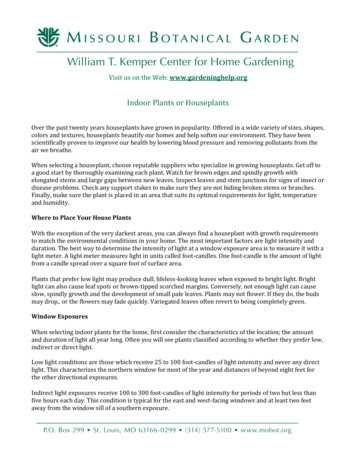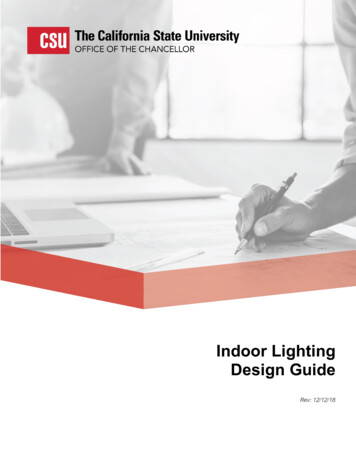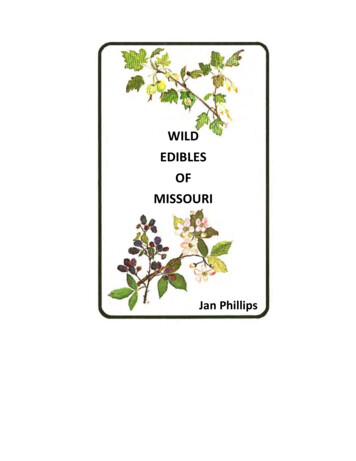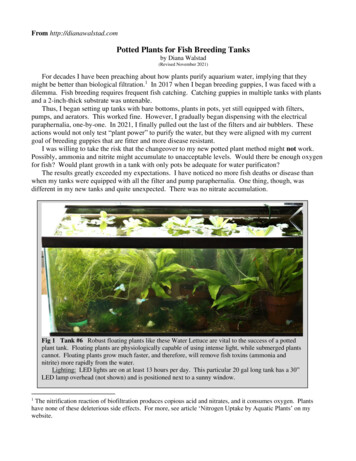
Transcription
Visit us on the Web: www.gardeninghelp.orgIndoor Plants or HouseplantsOver the past twenty years houseplants have grown in popularity. Offered in a wide variety of sizes, shapes,colors and textures, houseplants beautify our homes and help soften our environment. They have beenscientifically proven to improve our health by lowering blood pressure and removing pollutants from theair we breathe.When selecting a houseplant, choose reputable suppliers who specialize in growing houseplants. Get off toa good start by thoroughly examining each plant. Watch for brown edges and spindly growth withelongated stems and large gaps between new leaves. Inspect leaves and stem junctions for signs of insect ordisease problems. Check any support stakes to make sure they are not hiding broken stems or branches.Finally, make sure the plant is placed in an area that suits its optimal requirements for light, temperatureand humidity.Where to Place Your House PlantsWith the exception of the very darkest areas, you can always find a houseplant with growth requirementsto match the environmental conditions in your home. The most important factors are light intensity andduration. The best way to determine the intensity of light at a window exposure area is to measure it with alight meter. A light meter measures light in units called foot-candles. One foot-candle is the amount of lightfrom a candle spread over a square foot of surface area.Plants that prefer low light may produce dull, lifeless-looking leaves when exposed to bright light. Brightlight can also cause leaf spots or brown-tipped scorched margins. Conversely, not enough light can causeslow, spindly growth and the development of small pale leaves. Plants may not flower. If they do, the budsmay drop,. or the flowers may fade quickly. Variegated leaves often revert to being completely green.Window ExposuresWhen selecting indoor plants for the home, first consider the characteristics of the location; the amountand duration of light all year long. Often you will see plants classified according to whether they prefer low,indirect or direct light.Low light conditions are those which receive 25 to 100 foot-candles of light intensity and never any directlight. This characterizes the northern window for most of the year and distances of beyond eight feet forthe other directional exposures.Indirect light exposures receive 100 to 300 foot-candles of light intensity for periods of two but less thanfive hours each day. This condition is typical for the east and west-facing windows and at least two feetaway from the window sill of a southern exposure.
Generally, the west window receives higher light intensity and becomes hotter than an east window. Thewestern exposure would be characterized as having indirect light through the morning and early afternoon.Later in the day, direct light would penetrate the window exposure from four to six hours depending uponexterior obstructions and the time of year.The eastern exposure is characterized by indirect lighting for the majority of the day and through spring,fall and winter. In the late spring, summer and early fall, constant direct light would penetrate the window.The east window is a good site for many flowering plants that do well under cool conditions.Southern exposures receive the greatest amount of direct light. Direct light exposures receive between 300and 1000 foot-candles of light intensity and about five hours of direct sun. Few plants can survive the lightand heat intensity of this exposure with the exception of cacti and succulents.Temperature and HumidityA second factor often interrelated to light exposure is temperature. Generally, the temperature of the housegoverns this but a southern or western window exposure can become quite hot because of the sunlightpenetration and lack of air movement. Danger signs that conditions are too warm are wilting lower leaveswith brown margins, short-lived flowers and spindly growth. Conversely, keep your plants away from airconditioning vents in the summer. Sudden temperature fluctuations can cause rapid yellowing, droppingleaves. Curling leaves that turn brown and drop also indicate that it is too cold.Nearly all houseplants prefer a humidity level of 50% or more. Houseplants may suffer, especially duringthe winter, from a lack of humidity. A simple method to increase the humidity is to place plants in a pebbletray. This is a tray lined with pebbles and filled with enough water to reach to just below the pebble’ssurface. The water evaporates from the tray up into the air around the plants increasing the relativehumidity.Watering and FertilizingTo determine your plant’s water need, simply stick your index finger into the soil. Most plants are ready forwater if they are dry one-inch down from the surface of the soil. To water properly, most plants prefer areally thorough drink with tepid water. Moisten the soil completely until the water is coming out of thebottom of the pot. Do not let the plant sit in this drainage water.Overwatering is one of the most common causes of houseplant problems. Overwatering can cause leafspots which are soft and dark brown. It can also cause lower leaves to yellow and drop. Overwatered plantsmay look wilted. Both stems and leaves may rot. Overwatering can also cause houseplants to grow slowlyand flowers to fade quickly and drop.Too little water can cause leaf spots that are brown and brittle or blighted leaf margins. Lower leaves mayturn completely brown, dry up and drop off. Flower buds may fall off or the plant may produce no flowersat all.All houseplants need adequate amounts of food to grow. Look for a balanced plant food with an N-P-Kanalysis like 10-10-10. Feeding should be done only while the plant is actively growing or flowering. Threefeedings during the growing season, starting in April and extending through June, is usually sufficient. Themost commonly used plant foods are dissolved in water. Some gardeners prefer the encapsulated, slowrelease fertilizers that may be sprinkled on the soil surface or worked into the soil.
Over-fertilizing plants can cause brown, crisp leaf margins. Flowers may not develop on overfed plants. Awhite mineral crust on the outside of clay pots or on the soil surface is a sure fire sign that the plant is beingover fertilized.Grooming Your House PlantRemoving any shriveled or discolored leaves and cleaning dust from your house plant will not only make itlook more attractive; it also allows the plant to function more effectively. Leaves can be cleaned with a softcloth while supporting the leaf with one hand. Some gardeners use commercial leaf shiners. They should beused with care and in moderation. Liquid shiners should be applied with a soft cloth and never applieddirectly onto the plant. Monthly applications are more than sufficient.Some plants can benefit from an actual rain shower. Smaller plants can be washed by placing your handover the top of the pot to keep the soil from falling out, inverting the plant, immersing it in a solution ofmild soapy water and swirling it around for a few seconds. This is especially good if you suspect insectproblems.Some houseplants can get out of hand and deteriorate if not regularly pruned. Pruning can modify andredirect growth, improve structure, reduce size, as well as remove diseased branches and foliage. Prunewith sharp clean scissors or scissor action pruners. Stems can be removed to open up the plant. Newgrowth will be generated in the remaining stems or from the plant’s base. Stems pruned above a leaf or agrowth bud will develop one or more new tips making the plant appear denser.One simple technique to control growth is by pinching back the growth tip with your thumb and forefinger.Pinching is really pruning on a small scale. Pinching back the young growing tip causes the plant to branchout below the pinch, promoting new growth and a fuller plant.RepottingPlants in pots up to 10 inches in diameter should be repotted annually. Large container plants should berepotted every 2 years. This prevents the plant from becoming pot-bound. Pot-bound plants have very slowleaf and stem growth. The soil dries out quickly even with frequent watering and roots may begin to growout of the drainage hole.Move your plant to a container that is only slightly larger. Tip the plant out of its existing container usingyour open hand for support. Tease some of the roots away from the root ball and trim off long roots thatare twining. Place the plant in the new pot and fill it in with moistened potting soil. Water carefully andplace the plant in the shade. Wait for 2-3 weeks, and then move the plant back to its permanent quarters.Diseases and PestsSpots, rots, wilts and mildews on your houseplant are symptoms of disease. It is important to identify theproblem correctly so it can be treated effectively. Black shriveled sections of stem just above the soil linemay indicate a disease called blackleg caused by a fungus. Soft, slimy stems with black or brown decayedareas can be symptoms of crown rot, also caused by a fungus. Brown leaf spots which grow and merge canbe either bacterial or fungal leaf spot diseases. If any of these symptoms occur, a recommended treatmentincludes destroying infected leaves, using a fungicide and modifying cultural practices.There are a variety of pests which plague houseplants. Identify the pest and apply the appropriate remedyas soon as the first symptoms appear. Repeated treatments may be required to break the life cycle ofoverlapping generations of most of these insects.
Aphids are small sap-sucking insects, usually green, black or orange found on new, succulent growth. Theycause discoloration and distortion of the leaves and secrete sap called honeydew which can encourageblack fungal growth on leaves.Mealybugs appear as small white cottony tufts in clusters on the stems and underside of leaves. Mealybugscause wilting, yellowing and leaf drop.Scale looks like small, brown discs commonly attached to the underside of leaves along the veins and on thestems where they suck sap. Plant vigor will decrease, leaves will yellow and black fungal growth maydevelop on honeydew secretions.Spider mites, which are also sap-sucking pests, proliferate in hot, dry conditions. Infested leaves developyellow mottling and blotching and drop prematurely. You may find fine webbing on the leaves.Whitefly is a small, white, moth-like insect that can spread rapidly. Greenish larvae suck sap on theunderside of the leaves which then turn yellow and drop. When the plant is disturbed, the winged insectcan be seen flying out of the foliage.Cacti and Succulents as HouseplantsA group of plants called succulents that have either fleshy stems and/or leaves are often chosen ashouseplants for direct light conditions. Their ability to endure drought is reflected in the succulentleaf/stem condition where water is stored. These plants come from many plant families; most notably thecactus family. Others in this group come from sub-tropical areas where light conditions are less extremeand moisture is more abundant. This group is referred to as the jungle cacti and includes the Christmas,Thanksgiving and Orchid cacti.Cacti and succulents generally require at least 4 hours of bright, direct light each day. However, someincluding the jungle cacti, prefer medium light and should only receive direct light in winter.Most cacti and succulents tolerate the low humidity and warmth of the home. Jungle cacti require higherhumidity and should be placed on a tray of moistened pebbles or rocks. Some cacti will do better ifpresented with a rest period during the winter. Provide these plants with cool conditions and as brightlight as possible. Window sill and cool basements are good sites for these plants.The most frequent cause of problems with cacti is due to overwatering. To water cacti, check the moisturelevel by sticking the index finger into the soil. Generally, cacti will need watering every 2 to 3 weeks duringthe growing season and once a month in during the winter. It is best to allow the soil to dry out betweenwaterings.Jungle cacti should be kept evenly moist all year around, especially during the flowering period of late fallor early spring. When flowering has stopped, water should be withheld to allow the top of the soil to dryout before waterings.Cacti and Succulents Commonly Used as Houseplants - South WindowCommon NameScientific NameStar CactusAstrophytum spp.Old Man CactusCephalocereus senilisHedge CactusCereus spp.Rosary VineCeropegia woodiiCleistocactusCleistocactus spp.Jade PlantCrassula portulacea
Mexican FirecrackerBarrel CactusRainbow CactusEaster Lily CactusCrown-of-ThornsOld Lady CactusSnowball CactusSilver Cluster CactusRose PincushionPrickly PearCrown CactusStonecropOld Man CactusSpider CactusChain CactusTorch PlantTiger AloeKalanchoeString-of-beadsDonkey’s TailLiving StonesCrassula argenteaEcheveria elegansEchinocactus spp.Echinocereus dasyacanthusEchinopisi spp.Euphorbia miliiMammiliaria spp.Mammillaria bocasanaMammillaria proilferaMammiliaria zeilmannianaOpuntia microdasysRebutia spp.Sedium spp.Cephalocereus sensillisGymnociaycium denudatumRhiphsalis spp.Aloe aristataAloe variegataKalanchoe spp.Senecio rowleyanusSedum morganianumLithops spp.Plants for Indirect Light Conditions - West WindowCommon NameScientific NameChild/Pet Soil Moisture TemperatureSafeWetDryCoolWarmAloeAloe spp.NXVase Plant (Flowering)Aechmea miniata discolorSXXUrn Plant (Flowering)Aechmea fasciataSXXQueen’s-tearsBillbergia nutansSXXEarth-starCryptanthus spp.SBlushing BromeliadNeoregelia carolinaeUXXTillandsiaTillandsia cyaneaUXXCactiMany generaNXXCitrusMany spp.NCrotonCodiaeum variegatumNXXTi PlantCordyline terminalisSXXJade PlantCrassula argenteaSXXSago PalmCycas revolutaNXXFalse AraliaDizygotheca elegantissimaSXXPoinsettiaEuphorbia pulcherrimaUXXGardenia (Flowering)Fardenia jasminoidesUXXEnglish IvyHedera helixNXXAmaryllis (Flowering)Hippeastrum hybridsNXXXXXXX
New GuineaImpatiens (Flowering)Impatiens hybridsUXXGeranium (Flowering)Pelargonium x hortorumUXXAvocadoPersea americanaNXAzalea (Flowering)Rhododendron indicaNXChristmas Cactus (Flowering)Schlumbergera bridgesiiSXBird-of-ParadiseStrelitzia reginaeNXXSpineless YuccaYucca elephantipesNXXWandering JewZebrina hybridsSXXFishtail PalmCaryota urensNXXAreca PalmChrysalidocarpus lutescensSXXPleomeleDracaena reflexaSBloodleafIresine herbstiiUScrew PinePandanus veitchiiNPolysciasPolyscias balfourianaNXChrysanthemum (Flowering)Chrysanthemum spp.UXXLily (Flowering)Lillium spp.NXXPrimrose (Flowering)Primula spp.NXXKalanchoe (Flowering)Kalanchoe blossfeldianaUXXHibiscus (Flowering)Hibiscus spp.SXXExacum (Flowering)Exacum affineNXXWood SorrelOxalis spp.NXXPassion VineGynura aurantiacaSXXXXXXXXXXXXS Suitable for homes with children and pets; N Not suitable for homes with children and pets; U Unknown; Flowering a flowering plantPlants for Indirect Light Conditions - East WindowSoilTemperatureChild/Pet MoistureSafeWetDry CoolWarmCommon NameScientific NameNorfolk Island PineAraucaria heterophyllaSXXAsparagus FernAsparagus setaceusUXXRex Begonia (Flowering)Begonia x rex-cultorumNXXCattleya Orchids (Flowering) Cattleya spp.NXXSpider Plant (Flowering)Chlorophytum comosumSYellow-leaf Dumb CaneDiffenbachia maculataNXXPothosEpipremnum aureumNXXJapanese FatsiaFatsia japonicaUXXXX
Weeping FigFicus benjaminaSXXIndia Rubber PlantFicus elasticaSXXPrayer PlantMaranta leuconeuraNXXBoston FernNephrolepis exaltataSXAluminum PlantPilea cadiereiSXXStaghorn FernPlatycerium spp.SXXAfrican Violets (Flowering)Saintpaulia ionanthaSXXDwarf ScheffleraSchefflera arboricolaNPiggyback PlantTolmiea menziesiiSSpiderwortTradescantia spp.SMaidenhair FernAdiantum raddianumSUmbrella TreeBrassaia actinophyllaNPeacock PlantCalathea makoyanaNXXFishtail PalmCaryota urensNXXAreca PalmChrysalidocarpus lutescensSXXCoffee TreeCoffea arabicaNXXUmbrella PlantCyperus spp.NXXFatshederaFatshedera lizeiNXXWax PlantHoya carnosaNFan PalmLivistona chinesisNXPodocarpusPodocarpus marcophyllusNXPolysciasPolyscias balfourianaNXLady PalmRhapis excelsaSXOyster PlantRhoeo spathaceaNPigmy Date PalmPhoenix roebeleniiNXFlame Flower (Flowering)Episcia spp.NXFuchsia (Flowering)Fuchsia spp.UXXStreptocarpus (Flowering)Streptocarpus spp.UXXPocketbookPlant (Flowering)Calceolaria hybridsNXXGloxinia (Flowering)Gloxinia spp.SXXShrimp Plant (Flowering)Aphelandra squarrosaSXXCyclamen (Flowering)Cyclamen persicumNXElephant’s EarsCaladium spp.NXXMother-of-ThousandsSaxifraga stoloniferaNXXXXXXXXXXXXXXXXXXXXXXXXS Suitable for homes with children and pets; N Not suitable for homes with children and pets; U Unknown; Flowering a flowering plantPlants for Low Light Conditions - North Window
Common NameScientific NameChild/Pet Soil MoistureSafeWetDryTemperatureCoolWarmXXCast Iron PlantAspidistra elatiorSXXChinese EvergreenAglaonema modestumNXScrew PinePandanus veitchiiNParlor PalmChamaedorea elegansSGrape IvyCissus rhombifoliaUXCorn PlantDracaena fragransNXXStriped DracaenaDracaena deremensisNXXBaby Rubber PlantPeperomia obtusfoliaUXXBird’s Nest FernAsplenium nidusSDumb CaneDieffenbachia amoenaNXXSpotted Dumb CaneDieffenbachia maculataNXXMosaic PlantFittonia verschaffeltiiSXXSentry PlantHowea forsteranaSXXHeartleaf PhilodendronPhilodendron scandensoxycardiumNXPittosporumPittosporum tobiraSSwedish IvyPlectranthus australisSSnake PlantSansevieria trifasciataNSnowflowerSpathiphyllum floribundumNXArrowhead VineSyngonium podophyllumNXXMaidenhair fernAdiantum raddianumSXXCoralberryArdista crenataUXXBamboo PalmChamaedorea erumpensUXHolly FernCrytomium falcatumSXWax PlantHoya carnosaNLady PalmRhapis excelsaSXPeacock PlantCalathea makoyanaNXXXXXXXXXXXXXXXXXXXXXXXS Suitable for homes with children and pets; N Not suitable for homes with children and pets; U Unknown; Flowering a flowering plant
light meter. A light meter measures light in units called foot-candles. One foot-candle is the amount of light from a candle spread over a square foot of surface area. Plants that prefer low light may produce dull, lifeless-looking leaves when exposed to bright light. Bright light ca










